 Invaders #1 — Writer: Chip Zdarsky; Art: Carlos Magno with Butch Guice; Colors: Alex Guimaraes
Invaders #1 — Writer: Chip Zdarsky; Art: Carlos Magno with Butch Guice; Colors: Alex Guimaraes
Marvel Comics Presents #1 — Creators: Various
Black Widow #1 — Writers: Jen and Sylvia Soska; Art: Flaviano; Colors: Veronica Gandini
Why so much focus on the Submariner lately? He’s becoming a major Avengers villain, with Mad Max-y armor and a meaner, deadlier damn-the-surface-world attitude, while also co-starring in a revival of the original-team Defenders; this week, he’s featured prominently in two new series: the revived Invaders #1, and the anthology Marvel Comics Presents. Well, Marvel’s celebrating their 80th anniversary this year, and Prince Namor was their first superhero character, debuting in early 1939 in the low-distribution Motion Picture Funnies Weekly, and then later that year in Marvel Comics #1, so giving some love to their earliest creation makes sense. Invaders #1 has Jim Hammond, the  android Torch who also debuted in Marvel Comics #1, and Steve Rogers (a relative newcomer, whose Jack Kirby/Joe Simon-produced Captain America #1 didn’t show up until 1941) concerned about their old WWII ally Namor wanting to, you know, declare war on all land-dwellers, and enlisting Bucky/the Winter Soldier to help them; it toggles between those present-day conflicts and flashbacks to the War. It’s surprisingly good, with Carlos Magno and Butch Guice supplying detailed, period-appropriate art and Chip Zdarsky, better known for lighter fare like Howard the Duck, writing a suitably-dramatic script that uses Namor’s history to explain his current madness. Marvel Comics Presents is a relaunch of that anthology title, with three ten-page stories: the first part of a Wolverine serial — also set in WWII, at least at first — by Charles Soule, Paulo Siqueira and Oren Junior; Namor again, also during the war years, in a one-shot tale by Greg Pak and Tomm Coker; and another stand-alone story, starring the present-day Captain America, by Ann Nocenti, Greg Land and Jay Leisten. The one-offs are a good idea — the original Marvel Comics Presents sometimes suffered because an issue would consist entirely of the middle chapters of three or four different stories, which discouraged new readers — and the
android Torch who also debuted in Marvel Comics #1, and Steve Rogers (a relative newcomer, whose Jack Kirby/Joe Simon-produced Captain America #1 didn’t show up until 1941) concerned about their old WWII ally Namor wanting to, you know, declare war on all land-dwellers, and enlisting Bucky/the Winter Soldier to help them; it toggles between those present-day conflicts and flashbacks to the War. It’s surprisingly good, with Carlos Magno and Butch Guice supplying detailed, period-appropriate art and Chip Zdarsky, better known for lighter fare like Howard the Duck, writing a suitably-dramatic script that uses Namor’s history to explain his current madness. Marvel Comics Presents is a relaunch of that anthology title, with three ten-page stories: the first part of a Wolverine serial — also set in WWII, at least at first — by Charles Soule, Paulo Siqueira and Oren Junior; Namor again, also during the war years, in a one-shot tale by Greg Pak and Tomm Coker; and another stand-alone story, starring the present-day Captain America, by Ann Nocenti, Greg Land and Jay Leisten. The one-offs are a good idea — the original Marvel Comics Presents sometimes suffered because an issue would consist entirely of the middle chapters of three or four different stories, which discouraged new readers — and the 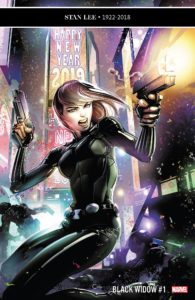 creative teams, all decent, offer an effective mix of styles, so this has a chance to do well. Black Widow revives that popular-especially-from-the-movies character, who died in Secret Empire and then got better; one of the hooks is that few people know she’s alive, so her undercover assignments are more effective. It’s really the first two chapters of the arc; the first sees Natasha helping Captain America take down some terrorists, while the second sends her to Madripoor (dressed up in a Wolverine-like white suit and eyepatch) to begin the actual mission; the writers, Jen and Sylvia Soska, add a charmingly-fannish editorial about how as sisters they grew up reading about these characters, and their enthusiasm, especially paired with Flaviano’s high-energy, design-oriented art, helps to carry the day.
creative teams, all decent, offer an effective mix of styles, so this has a chance to do well. Black Widow revives that popular-especially-from-the-movies character, who died in Secret Empire and then got better; one of the hooks is that few people know she’s alive, so her undercover assignments are more effective. It’s really the first two chapters of the arc; the first sees Natasha helping Captain America take down some terrorists, while the second sends her to Madripoor (dressed up in a Wolverine-like white suit and eyepatch) to begin the actual mission; the writers, Jen and Sylvia Soska, add a charmingly-fannish editorial about how as sisters they grew up reading about these characters, and their enthusiasm, especially paired with Flaviano’s high-energy, design-oriented art, helps to carry the day.
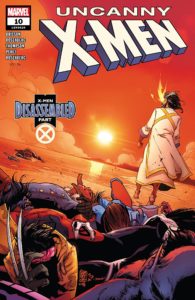 Uncanny X-Men #10 (Legacy #629) — Writers: Matthew Rosenberg, Kelly Thompson and Ed Brisson; Art: Pere Perez; Colors: Rachelle Rosenberg
Uncanny X-Men #10 (Legacy #629) — Writers: Matthew Rosenberg, Kelly Thompson and Ed Brisson; Art: Pere Perez; Colors: Rachelle Rosenberg
Return of Wolverine #4 (of 5) — Writer: Charles Soule; Art: Declan Shalvey; Colors: Laura Martin
Conan the Barbarian #2 (Legacy #277) — Writer: Jason Aaron; Art: Mahmud Asrar; Colors: Matthew Wilson
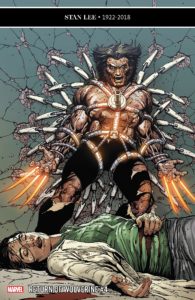 True Believers: Conan the Barbarian — Curse of the Golden Skull #1 (of 1) — Writer: Roy Thomas; Art: Neal Adams; Colors: Glynnis Wein
True Believers: Conan the Barbarian — Curse of the Golden Skull #1 (of 1) — Writer: Roy Thomas; Art: Neal Adams; Colors: Glynnis Wein
True Believers: Conan the Barbarian — Queen of the Black Coast! #1 (of 1) — Writer: Roy Thomas; Pencils: John Buscema; Inks: Steve Gan; Colors: Michelle Wolfman
 Uncanny X-Men #10 has one of those victorious-villain-walking-away-from-dead-heroes covers that, atypically, turns out to be true: no more X-Men. Disassembled. Gone. Until next month, at any rate, when a batch of temporary new titles (The Amazing Nightcrawler; Next Gen; X-Tremists, Marvelous X-Men, etc.) begin to explore the new world thus created. This is, of course, a tribute to the almost-25-year-old Age of Apocalypse story that created Nate Grey in the first place, and experienced comics readers will suspect that, as with that event, things will snap back to normal in due course —
Uncanny X-Men #10 has one of those victorious-villain-walking-away-from-dead-heroes covers that, atypically, turns out to be true: no more X-Men. Disassembled. Gone. Until next month, at any rate, when a batch of temporary new titles (The Amazing Nightcrawler; Next Gen; X-Tremists, Marvelous X-Men, etc.) begin to explore the new world thus created. This is, of course, a tribute to the almost-25-year-old Age of Apocalypse story that created Nate Grey in the first place, and experienced comics readers will suspect that, as with that event, things will snap back to normal in due course — 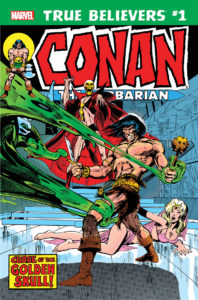 especially considering the last-page appearance of a certain hooded, red-sunglasses-wearing character here. Yet another years-absent X-member, the original Wolverine, is almost back himself: Return of Wolverine offers its penultimate issue this week, and while its high-powered Soule/Shalvey/Martin creative team hasn’t quite lived up to expectations, that’s partly because everyone’s more interested in the result — getting Logan back, already — than how it happens. Yet another long-absent Marvel mainstay, Conan the Barbarian, is also back; the second
especially considering the last-page appearance of a certain hooded, red-sunglasses-wearing character here. Yet another years-absent X-member, the original Wolverine, is almost back himself: Return of Wolverine offers its penultimate issue this week, and while its high-powered Soule/Shalvey/Martin creative team hasn’t quite lived up to expectations, that’s partly because everyone’s more interested in the result — getting Logan back, already — than how it happens. Yet another long-absent Marvel mainstay, Conan the Barbarian, is also back; the second  issue of his revival appears this week, with writer Jason Aaron switching between early- and late-career Conans in much the same way he played with young/current/ancient Thors over in that title; it was an effective move there, and seems to be working well here too. Accompanying the new issue are two more “True Believers” reprints, both written by Roy Thomas and both notable for their artists: #37’s “Curse of the Golden Skull” has Neal Adams, while #58’s “Queen of the Black Coast,” with the first appearance of the pirate/love interest Belit, is by John Buscema, who with somewhere north of 300 stories about the surly Cimmerian eclipses even Barry Smith as his premiere artist.
issue of his revival appears this week, with writer Jason Aaron switching between early- and late-career Conans in much the same way he played with young/current/ancient Thors over in that title; it was an effective move there, and seems to be working well here too. Accompanying the new issue are two more “True Believers” reprints, both written by Roy Thomas and both notable for their artists: #37’s “Curse of the Golden Skull” has Neal Adams, while #58’s “Queen of the Black Coast,” with the first appearance of the pirate/love interest Belit, is by John Buscema, who with somewhere north of 300 stories about the surly Cimmerian eclipses even Barry Smith as his premiere artist.
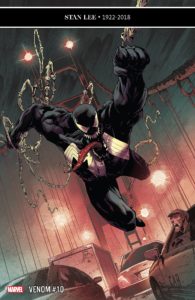 Venom #10 — Writer: Donny Cates; Pencils: Ryan Stegman; Inks: JP Mayer; Colors: Frank Martin
Venom #10 — Writer: Donny Cates; Pencils: Ryan Stegman; Inks: JP Mayer; Colors: Frank Martin
Marvel Tales: Venom #1 — Creators: Various
Amazing Spider-Man #13 (Legacy #812) — Writer: Nick Spencer; Pencils: Ryan Ottley; Inks: Cliff Rathburn; Colors: Laura Martin and Andrew Crossley
Fantastic Four #6 (Legacy #651) — Writer: Dan Slott; Art: Aaron Kuder; Colors: Marte Gracia and Erick Arciniega
 Ironheart #2 — Writer: Eve L. Ewing; Art: Luciano Vecchio; Layouts: Geoffo; Colors: Matt Milla
Ironheart #2 — Writer: Eve L. Ewing; Art: Luciano Vecchio; Layouts: Geoffo; Colors: Matt Milla
Donny Cates is developing an interesting rhythm on Venom during his current run: a huge battle with an alien dragon/god, followed by a couple of quieter issues looking into Eddie’s family life and upbringing (violent-jerk dad, half-brother he never knew about, etc.), followed by a major health revelation at the end of this issue; the combo of action and character bits works quite well, and should 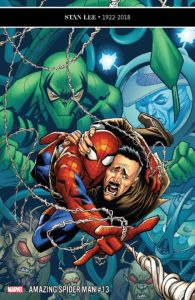 keep this book where he’s put it: near the top of the sales charts. That can also be seen from the other symbiote-centric offering this week: Marvel Tales: Venom. It’s a reprint anthology featuring three comics: the Todd McFarlane-drawn Venom appearance from Amazing Spider-Man #316; the first Carnage, from ASM #361, and a (Venom-free) Spidey-Sabretooth battle from Peter Parker, the Spectacular Spider-Man #119. Those first two comics are relatively expensive, so the $7.99 price isn’t a bad deal if you’ve never read them.
keep this book where he’s put it: near the top of the sales charts. That can also be seen from the other symbiote-centric offering this week: Marvel Tales: Venom. It’s a reprint anthology featuring three comics: the Todd McFarlane-drawn Venom appearance from Amazing Spider-Man #316; the first Carnage, from ASM #361, and a (Venom-free) Spidey-Sabretooth battle from Peter Parker, the Spectacular Spider-Man #119. Those first two comics are relatively expensive, so the $7.99 price isn’t a bad deal if you’ve never read them.  Amazing Spider-Man itself continues its relaunch, with issue #13 featuring a sort-of-reformed J. Jonah Jameson having old sins (the Scorpion, the Spider-robots, etc.) coming back to haunt him; under Nick Spencer and Ryan Ottley this has been a breezy, fast-paced and fun run (and, if you’re a Chris Bachalo fan, the ad for the next issue says he’s doing the interior art for that one, so get ready…). Meanwhile, Fantastic Four, having married Ben and Alicia last time, now gears up for a Galactus/Dr. Doom/FF tag-team battle; former longtime Spidey scribe Dan Slott has made
Amazing Spider-Man itself continues its relaunch, with issue #13 featuring a sort-of-reformed J. Jonah Jameson having old sins (the Scorpion, the Spider-robots, etc.) coming back to haunt him; under Nick Spencer and Ryan Ottley this has been a breezy, fast-paced and fun run (and, if you’re a Chris Bachalo fan, the ad for the next issue says he’s doing the interior art for that one, so get ready…). Meanwhile, Fantastic Four, having married Ben and Alicia last time, now gears up for a Galactus/Dr. Doom/FF tag-team battle; former longtime Spidey scribe Dan Slott has made  this readable, character-centric and action-filled, and done well by Marvel’s original stars during their current comeback. Ironheart looks at the Iron Man spinoff character Riri Williams, as she juggles college, superheroing, tech repairs, inventions and a local missing-child case; those elements put it firmly in the Marvel YA/STEM/girl empowerment category (along with The Unstoppable Wasp and The Unbeatable Squirrel Girl, especially, even if Riri’s lacking an imposing adjective as part of her title…), although there’s plenty of continuity-meshing with the regular Marvel universe, and enough decent character-building, to make it accessible and entertaining to everybody else, too.
this readable, character-centric and action-filled, and done well by Marvel’s original stars during their current comeback. Ironheart looks at the Iron Man spinoff character Riri Williams, as she juggles college, superheroing, tech repairs, inventions and a local missing-child case; those elements put it firmly in the Marvel YA/STEM/girl empowerment category (along with The Unstoppable Wasp and The Unbeatable Squirrel Girl, especially, even if Riri’s lacking an imposing adjective as part of her title…), although there’s plenty of continuity-meshing with the regular Marvel universe, and enough decent character-building, to make it accessible and entertaining to everybody else, too.
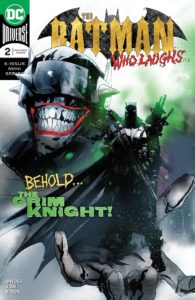 The Batman Who Laughs #2 (of 6) — Writer: Scott Snyder; Art: Jock; Colors: David Bareon
The Batman Who Laughs #2 (of 6) — Writer: Scott Snyder; Art: Jock; Colors: David Bareon
Goddess Mode #2 — Writer: Zoe Quinn; Art: Robbi Rodriguez; Colors: Rico Renzi
Superman #7 — Writer: Brian Michael Bendis; Art: Ivan Reis and Brandon Peterson with Jason Fabok; Colors: Oclair Albert and Alex Sinclair
Suicide Squad #50 — Writer: Rob Williams; Art: German Peralta, Brent Schoonover and Will Conrad; Colors: Gabe Eltaeb
The Batman Who Laughs has an irresistible hook: he’s an alternate-universe Dark Knight who got infected by the Joker’s madness, and so is insane but still has all of his bat-skills and strategic brilliance. How “our” Batman can beat him is a good question, especially considering this is only the second of six issues, but the Scott Snyder/Jock team doesn’t look like it’ll have any problem keeping us on the edges of our seats along the way. Goddess Mode is about a near-future tech girl discovering a computer-generated world and going on a reluctant hero’s quest in it; the first issue was mostly backstory/setup, but this one introduces 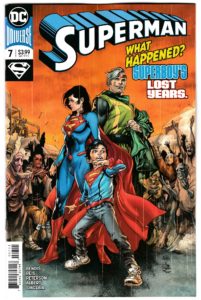 her companions and adversaries, explains the stakes and gets the digital ball rolling; pick up this issue and the previous one, still on the stands, and together they offer a good start to a stylishly-drawn, well-conceived adventure. Superman starts a new arc with son Jon Kent returning from his trip to outer space — but, while it’s only been three weeks ago for everyone on Earth, for him it’s taken seven years to get back, so now he’s seventeen instead of ten years old; we get Superman and Lois dealing with that wrinkle, and then the beginning of Jon’s story about what happened. Whether this change will be permanent is anyone’s guess, but as the Bendis era on the Man of Steel keeps rolling
her companions and adversaries, explains the stakes and gets the digital ball rolling; pick up this issue and the previous one, still on the stands, and together they offer a good start to a stylishly-drawn, well-conceived adventure. Superman starts a new arc with son Jon Kent returning from his trip to outer space — but, while it’s only been three weeks ago for everyone on Earth, for him it’s taken seven years to get back, so now he’s seventeen instead of ten years old; we get Superman and Lois dealing with that wrinkle, and then the beginning of Jon’s story about what happened. Whether this change will be permanent is anyone’s guess, but as the Bendis era on the Man of Steel keeps rolling  along, smoothly and with flair, it’s so far been ery hard to resist. Suicide Squad reaches an anniversary issue, its 50th, with the double-sized conclusion of a trip to Russia to deal with a world-threatening infection linked to the Tunguskan asteroid explosion — and also linked to original Squad leader Rick Flag and his Task Force X; if you haven’t checked in on the title in a while, it’s a good time to return, with a reluctant Boomerang and Deadshot trying to save the day (assuming they can’t just sneak away…), a twenty-foot-tall fire-demon-possessed Amanda Waller, Harley with her hammer, and the other usual suspects that have kept this book popular, in its various incarnations, for over thirty years now.
along, smoothly and with flair, it’s so far been ery hard to resist. Suicide Squad reaches an anniversary issue, its 50th, with the double-sized conclusion of a trip to Russia to deal with a world-threatening infection linked to the Tunguskan asteroid explosion — and also linked to original Squad leader Rick Flag and his Task Force X; if you haven’t checked in on the title in a while, it’s a good time to return, with a reluctant Boomerang and Deadshot trying to save the day (assuming they can’t just sneak away…), a twenty-foot-tall fire-demon-possessed Amanda Waller, Harley with her hammer, and the other usual suspects that have kept this book popular, in its various incarnations, for over thirty years now.
![]() Avatar: Tsu’tey’s Path #1 — Writer: Sherri Smith; Pencils: Jan Duursema; Inks: Dan Parsons; Colors: Wes Dzioba
Avatar: Tsu’tey’s Path #1 — Writer: Sherri Smith; Pencils: Jan Duursema; Inks: Dan Parsons; Colors: Wes Dzioba
Deadly Class #36 — Writer: Rick Remender; Art: Wes Craig; Colors: Jordan Boyd
Dick Tracy #3 — Writers: Lee and Michael Allred; Pencils: Rich Tommaso; Inks: Michael Allred; Colors: Laura Allred
Lodger #3 — Writers: David and Maria Lapham; Art: David Lapham
The Wicked and the Divine #41 — Writer: Kieron Gillen; 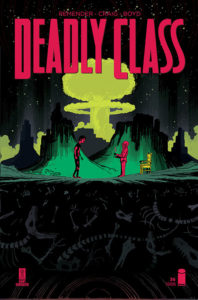 Art: Jamie McKelvie; Colors: Matthew Wilson
Art: Jamie McKelvie; Colors: Matthew Wilson
A Walk Through Hell #7 — Writer: Garth Ennis; Art: Goran Sudzuka; Colors: Ive Svorcina
Lumberjanes #58 — Writers: Shannon Watters and Kat Leyh; Art: AnnMarie Rogers; Colors: Maarta Laiho
Avatar benefits from the Jan Duursema art; she knows her way around fantasy/sf franchises, having spent long tenures on Advanced Dungeons and Dragons, Arion and  Warlord for DC, and on a ton of Dark Horse Star Wars comics, and her almost forty years of experience yield lush, believable, exotic, easy-to-like art. Deadly Class returns after a long hiatus, but it had a good excuse — creator Rick Remender just spent two years getting the comic developed and produced as a TV series (it debuted on the SyFy Network this week) and working as its showrunner. If you’re new to this title because of the TV show, maybe don’t start with this issue — like Walking Dead, it’s far ahead of the show — but from the beginning, with the trade collections. Former readers? Jump right
Warlord for DC, and on a ton of Dark Horse Star Wars comics, and her almost forty years of experience yield lush, believable, exotic, easy-to-like art. Deadly Class returns after a long hiatus, but it had a good excuse — creator Rick Remender just spent two years getting the comic developed and produced as a TV series (it debuted on the SyFy Network this week) and working as its showrunner. If you’re new to this title because of the TV show, maybe don’t start with this issue — like Walking Dead, it’s far ahead of the show — but from the beginning, with the trade collections. Former readers? Jump right  back in: its 1980s-set tale of a teen loner stumbling into a high school for assassins, and trying to survive there, has the same combination of over-the-top action, soap-opera twists and romance, and thoughtful themes as ever (like Buffy the Vampire Slayer, it’s about living through any high school, not just supernatural or overtly-murderous ones). Dick Tracy continues to channel Chester Gould’s original primitive gonzo energy better than anything since (better than Gould himself, in the last twenty years he was on the strip), thanks to the surprising combination of Rich Tomasso and the Allred family — brothers Lee and Michael
back in: its 1980s-set tale of a teen loner stumbling into a high school for assassins, and trying to survive there, has the same combination of over-the-top action, soap-opera twists and romance, and thoughtful themes as ever (like Buffy the Vampire Slayer, it’s about living through any high school, not just supernatural or overtly-murderous ones). Dick Tracy continues to channel Chester Gould’s original primitive gonzo energy better than anything since (better than Gould himself, in the last twenty years he was on the strip), thanks to the surprising combination of Rich Tomasso and the Allred family — brothers Lee and Michael 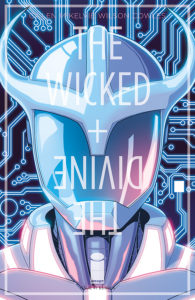 as co-writers, Michael on inks, and Laura on colors. The attraction of the original strip was always its potato-chip-like allure: you couldn’t possibly read just one episode without being compelled to see what happened next. That’s the hardest thing in the world to duplicate, yet the team here has managed it — pick up an issue and see. Lodger is another family affair: the latest noir comic from David Lapham (Stray Bullets), with his wife Maria co-writing; it’s about a travel blogger who’s actually a chameleonlike serial killer, and the girl whose family he destroyed who’s now
as co-writers, Michael on inks, and Laura on colors. The attraction of the original strip was always its potato-chip-like allure: you couldn’t possibly read just one episode without being compelled to see what happened next. That’s the hardest thing in the world to duplicate, yet the team here has managed it — pick up an issue and see. Lodger is another family affair: the latest noir comic from David Lapham (Stray Bullets), with his wife Maria co-writing; it’s about a travel blogger who’s actually a chameleonlike serial killer, and the girl whose family he destroyed who’s now 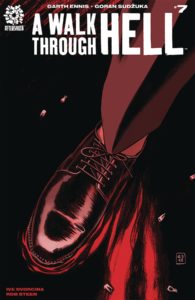 stalking him; it offers the same well-drawn lowlifes, innocents, violence and psychological horror that we’ve come to expect from him. The Wicked and the Divine, having spent over four years building its characters and their world, and with only a handful of issues left, hurtles to its conclusion; their runs on Young Avengers (and, earlier, the Phonogram trilogy) make anything Kieron Gillen and Jamie McKelvie produce worth our time — but, as with Deadly Class, start it from the beginning, with the trades, and watch the characters move toward their various, and well-earned fates, some
stalking him; it offers the same well-drawn lowlifes, innocents, violence and psychological horror that we’ve come to expect from him. The Wicked and the Divine, having spent over four years building its characters and their world, and with only a handful of issues left, hurtles to its conclusion; their runs on Young Avengers (and, earlier, the Phonogram trilogy) make anything Kieron Gillen and Jamie McKelvie produce worth our time — but, as with Deadly Class, start it from the beginning, with the trades, and watch the characters move toward their various, and well-earned fates, some  redeemed and others not, in a fascinating, twist-filled story that’s far from over.. A Walk Through Hell, seven issues in, finally begins to explain its plot; it’s suitably, apocalyptically chilling. Ennis has satirized traditional religious heaven/hell mythologies frequently in his stories, and this is a particularly grim example, hard to turn away from even as it narrows the chances for any happy ending. That leaves Lumberjanes, A Walk In Hell‘s thematic opposite, using its supernatural backdrop to cover themes of friendship and inclusion, where the happy ending, even with a couple of bumps and bruises and sadness before the end, is both assumed and welcomed.
redeemed and others not, in a fascinating, twist-filled story that’s far from over.. A Walk Through Hell, seven issues in, finally begins to explain its plot; it’s suitably, apocalyptically chilling. Ennis has satirized traditional religious heaven/hell mythologies frequently in his stories, and this is a particularly grim example, hard to turn away from even as it narrows the chances for any happy ending. That leaves Lumberjanes, A Walk In Hell‘s thematic opposite, using its supernatural backdrop to cover themes of friendship and inclusion, where the happy ending, even with a couple of bumps and bruises and sadness before the end, is both assumed and welcomed.



